Non-Proton MRS/MRI
Oral
Spectroscopy & Non-Proton MR
Wednesday, 20 June 2018
| S02 |
16:15 - 18:15 |
Moderators: Jens Rosenberg, Monique Bernard |
16:15
 |
0903.
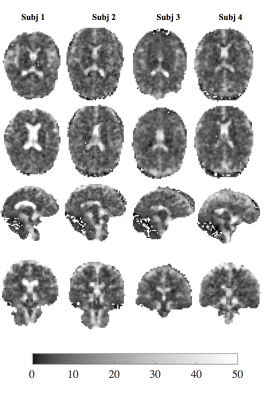 |
 A Continuum of Components: Robust Parameter Mapping in Sodium MRI A Continuum of Components: Robust Parameter Mapping in Sodium MRI
Warda Syeda, Yasmin Blunck, Amanda Ng, Jon Cleary, Leigh Johnston
Bi-exponential models of T2*-weighted sodium data are prone to producing noisy parameter maps and low contrast between brain tissue types. Further, inherently low SNR has, to this point, necessitated a constant fast fraction weight. Here, a continuum model of sodium T2*-decay is introduced and applied to in vivo human multi-echo 7T data, producing high quality, high contrast parameter maps, and informative voxelwise estimates of the relative weighting between fast and slow decay components.
|
16:27
 |
0904.
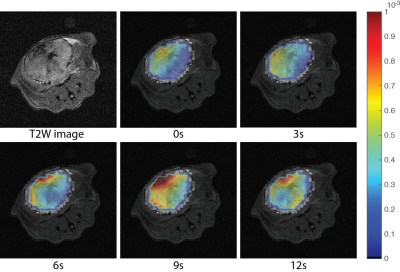 |
 High Field Hyperpolarized C-13 Dynamic Diffusion Weighted Imaging Based on Slice Selective Double Spin Echo Sequence High Field Hyperpolarized C-13 Dynamic Diffusion Weighted Imaging Based on Slice Selective Double Spin Echo Sequence
Xucheng Zhu, Jeremy Gordon, Robert Bok, Peder Larson
We designed and optimized a dynamic double spin echo (DSE) acquisition scheme for hyperpolarized(HP) 13C metabolites dynamic diffusion weighted imaging(DWI). Compared to traditional DSE sequence, our sequence could provide higher SNR for longer dynamic imaging duration. Our studies on TRAMP mice indicate a dynamic change of HP lactate ADC over time, which might have potential to improve the assessment of aggressive cancers.
|
16:39
|
0905.
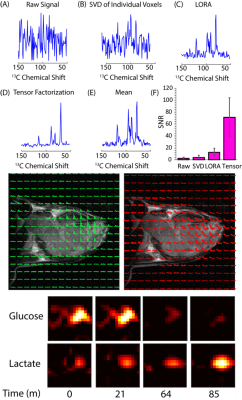 |
 PET by MRI: Glucose Imaging by 13C MRS by Noise Suppression through Tensor Decomposition Rank Reduction PET by MRI: Glucose Imaging by 13C MRS by Noise Suppression through Tensor Decomposition Rank Reduction
Jeffrey Brender, Shun Kishimoto, Hellmut Merkle, Galen Reed, Ralph Hurd, Albert Chen, Jan Ardenkjaer-Larsen, Jeeva Munasinghe, Keita Saito, Tomohiro Seki, Nobu Oshima, Kazu Yamamoto, James Mitchell, Murali Krishna
We show here a new method of imaging glucose metabolism in vivo by 13C MRS without DNP that relies on a simple but efficient postprocessing procedure using the higher dimensional analogue of SVD, tensor decomposition. Using this procedure, without sacrificing accuracy, we achieve an order of magnitude increase in SNR in both DNP and non-hyperpolarized single voxel experiments. In CSI imaging experiments, we see an approximately 30 fold increase in SNR, enough that the glucose to lactate conversions can be imaged with a time resolution of 12 seconds and an overall spatial resolution that compares favorably to 18F-FDG PET.
|
16:51
|
0906.
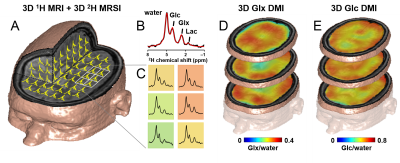 |
 Deuterium Metabolic Imaging (DMI) of Human Brain Glucose Metabolism Deuterium Metabolic Imaging (DMI) of Human Brain Glucose Metabolism
Henk De Feyter, Kevin Behar, Peter Brown, Scott McIntyre, Terence Nixon, Douglas Rothman, Robin de Graaf
Deuterium Metabolic Imaging (DMI) is a novel approach providing high 3D spatial resolution metabolic data from both animal models and human subjects. DMI relies on 2H MRSI in combination with administration of 2H-labeled substrates. We show how DMI combined with administration of [6,6’-2H2]-glucose can image glucose uptake and metabolism at high spatial resolution in human brain at 4T. We provide longitudinal and transverse relaxation times of 2H-labeled brain metabolites at 4T and 11.7T to support further development and optimization of DMI applications.
|
17:03
|
0907.
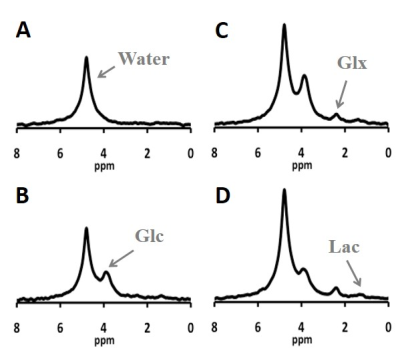 |
A Pilot Study for In Vivo Measurement and Quantification of Brain Glucose Metabolic Rates using Oral Uptake of Deuterated Glucose
Video Permission Withheld
Ming Lu, Xiao-Hong Zhu, Yi Zhang, Wei Chen
Recently, we developed a novel Deuterium MRS (DMRS) approach for simultaneously measuring cerebral glucose consumption rate and TCA cycle flux in rat brains at 16.4 T. Instead of using a clamp protocol in 13C MRS studies, our DMRS approach utilizes a brief i.v. infusion of glucose isotope. In this work, we aimed to establish a completely noninvasive delivery of the tracer into brain. By using oral uptake, DMRS detection sensitivity was evaluated and metabolic rates were quantified. Our results demonstrated the feasibility of using oral uptake for DMRS applications, which makes it highly suitable and promising for translation to patients.
|
17:15
 |
0908.
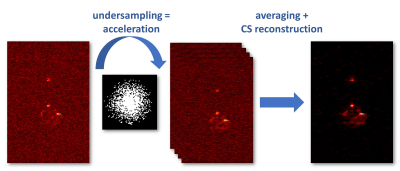 |
 Compressed Sensing Improves Detection of Fluorine-19 Nanoparticles in a Mouse Model of Neuroinflammation Compressed Sensing Improves Detection of Fluorine-19 Nanoparticles in a Mouse Model of Neuroinflammation
Ludger Starke, Sonia Waiczies, Thoralf Niendorf, Andreas Pohlmann
Low sensitivity remains a major challenge on the way to utilizing the full potential of 19F-MRI, despite its unique detection specificity for imaging inflammation. Compressed sensing allows the reconstruction of high quality images from severely undersampled data by relying on prior statistical knowledge. We show that investing the gained acquisition speed into increased averaging improves the detection of 19F-nanoparticles in an EAE mouse model. Thus compressed sensing helps to improve the sensitivity of 19F-MRI. This paves the way to enhanced spatial and temporal resolution for future in vivo studies.
|
17:27
|
0909.
 |
 Systemic Inflammation Adversely Affects Mitochondrial Function as Assessed by 31P MRS of Thigh Muscle with Exercise Systemic Inflammation Adversely Affects Mitochondrial Function as Assessed by 31P MRS of Thigh Muscle with Exercise
Nicholas Brennan, Kenneth Fishbein, David Reiter, Richard Spencer, Luigi Ferrucci
Systemic inflammation has been shown to play a role in both the aging process and disease progression. However, the effect of inflammation on mitochondrial function has not been fully elucidated. We hypothesized that increased systemic inflammation, assessed through measurement of conventional markers of inflammation, would be accompanied by a decrease in mitochondrial function, as assessed by 31P MRS of leg muscle. Our results suggest that increased systemic inflammation may adversely affect mitochondrial function.
|
17:39
|
0910.
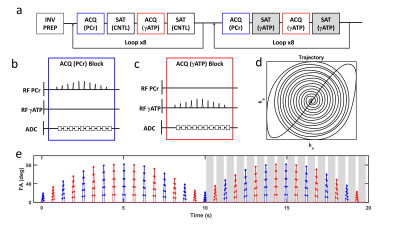 |
 Mapping of Creatine Kinase Reaction Rate in Rat Hindlimb by 31P Magnetic Resonance Fingerprinting Mapping of Creatine Kinase Reaction Rate in Rat Hindlimb by 31P Magnetic Resonance Fingerprinting
Charlie Wang, Yuchi Liu, Yuning Gu, Sherry Huang, Mark Griswold, Nicole Seiberlich, Xin Yu
Magnetic Resonance Fingerprinting (MRF) allows the quantification of multiple tissue parameters with high efficiency. Previously, we developed an MRF based 31P spectroscopic method for fast and robust measurement of ATP synthesis via creatine kinase (CK). In the current study, we explored the potential of combining the CK-MRF method with fast imaging for metabolic mapping of the CK reaction rate in small laboratory animals. CK-MRF imaging was performed in the hindlimb of four rats. CK rates of different muscle compartments were compared.
|
17:51
 |
0911.
 |
 Accelerating Low-Rank Tensor Model Based Dynamic 31P-MRSI of Ischemia-Reperfusion in Rat at 9.4T Accelerating Low-Rank Tensor Model Based Dynamic 31P-MRSI of Ischemia-Reperfusion in Rat at 9.4T
Bryan Clifford, Yuning Gu, Yudu Li, Yuchi Liu, Fan Lam, Zhi-Pei Liang, Xin Yu
Dynamic 31P-MRS/MRSI is often used to assess mitochondrial oxidative capacity in skeletal muscle by monitoring the depletion and recovery of the phosphocreatine concentration during ischemia-reperfusion experiments. In animal models, standard methods are unable to provide the spatiotemporal resolution needed to discern spatial heterogeneity of the recovery process ($$$<$$$10 s/frame, $$$\approx$$$1 mm3 per voxel). To address this problem, we have improved a recently proposed low-rank tensor based method for accelerated high-resolution dynamic 31P-MRSI to provide in vivo results with 1.5x1.5x2 mm3 nominal spatial resolution, 36 ppm spectral bandwidth, 0.14 ppm spectral resolution, and 5.1 s temporal resolution.
|
18:03
|
0912.
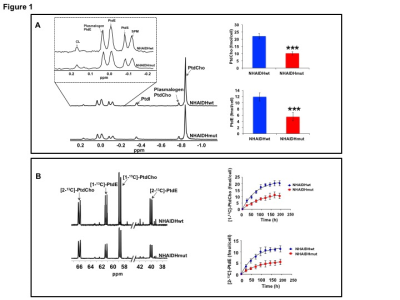 |
 Down-regulation of phospholipid biosynthesis is a unique metabolic feature of mutant IDH1 gliomas mediated by autophagy of the endoplasmic reticulum Down-regulation of phospholipid biosynthesis is a unique metabolic feature of mutant IDH1 gliomas mediated by autophagy of the endoplasmic reticulum
Pavithra Viswanath, Russell Pieper, Joanna Phillips, Sabrina Ronen
Virtually every cancer studied so far shows elevated choline and ethanolamine phospholipid metabolism, which has emerged as a metabolic hallmark of cancer. Here, we show that, unusually, low-grade gliomas carrying a mutation in isocitrate dehydrogenase 1 (IDHmut) down-regulate phosphatidylcholine and phosphatidylethanolamine biosynthesis and steady-state levels. Mechanistically, this down-regulation is mediated via autophagic degradation of the endoplasmic reticulum, the site of phospholipid biosynthesis. Importantly, the autophagy inhibitor chloroquine restores phospholipid levels and abrogates IDHmut tumor growth, identifying a potential therapeutic opportunity. Thus, our study demonstrates that IDHmut gliomas uniquely down-regulate phospholipid biosynthesis and that this phenomenon can be exploited for therapy.
|
|













